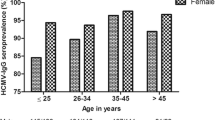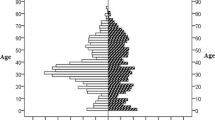Abstract
The aim of this paper is to compare the seroprevalence of cytomegalovirus (CMV) in women in the Autonomous Region of Madrid (ARM) obtained in two different years (1993 and 1999), according to age and seroprevalence of a virus transmitted by the faecal–oral route (hepatitis A virus, HAV) and another virus of respiratory transmission (varicella zoster virus, VZV). A total of 1813 serum samples were studied, taken from females aged 2–40 in two different serosurveys which were representative of the general population in the ARM. Of these, 933 were taken in 1993, and 880 in 1999. In each survey the samples were distributed over six groups, according to age group (2–5, 6–10, 11–15, 16–20, 21–30 and 31–40 years). CMV- and VZV-specific IgG was tested by indirect ELISA (Dade-Behring, Germany); and HAV–IgG by ImX (Abbott, USA) in the 1993 samples, or by Vidas (BioMérieux, France) in the case of those taken in 1999. A significant age-related rise in CMV seroprevalence was observed in both serosurveys. The seroprevalence obtained was lower in all age groups in 1999 than in 1993. The differences were statistically significant in two age groups: 6–10 years old (43.7 vs. 56.7%) and 31–40 years old (79.1 vs. 90.3%). In the younger age groups concurrent seroprevalence of CMV and VZV was significant lower in 1999. In older age groups a significant decrease in concurrent seroprevalence of both CMV and HAV was also seen. Agreement between serological results for CMV–HAV, CMV–VZV and HAV–VVZ during the two time periods and in every age group was poor or fair (κ index ≤ 0.2 or between 0.21 and 0.4) in all age groups. To conclude, a change in CMV epidemiology seems to be taking place in Madrid. The increase in the proportion of CMV seronegative women of childbearing age may have some impact on the incidence of congenital diseases related to vertical transmission of CMV. Apparently, such a change, among children, could be related to a lower close contact transmission rate (as in VZV), and among adults to improvements in standards of public health (as in HAV). However, due to the poor or fair agreement between serological results for CMV–HAV, CMV–VZV and HAV–VVZ, other independent factors may affect the fall in CMV seroprevalence.
Similar content being viewed by others
References
Griffiths PD, Emery VC. Cytomegalovirus. In: Richman DD, Whitley RJ, Hayden FG (eds), Clinical virology. New York: Churchill Livingstone, 1997: 445-470.
Arvin AM. Human Cytomegalovirus. In: Lennette EH (ed), Laboratory diagnosis of viral infections. New York: Marcel Dekker, 1992: 333-350.
Hutto C, Little EA, Ricks R, Lee JD, Pass RF. Isolation of cytomegalovirus from toys and hands in a day care center. J Infect Dis 1986; 154: 527-530.
Adler S. Transfusion associated cytomegalovirus infections. Rev Infect Dis 1983; 5: 977-993.
Van der Meer JTM, Drew WL, Bowden RA, et al. Summary of the International Consensus Symposium on Advances in the Diagnosis, Treatment and Prophylaxis of Cytomegalovirus Infection. Antiviral Res 1996; 32: 119-140.
De Ory F, Sanz JC, Castañeda R, Ramirez R, León P, Pachón I. Seroepidemiología frente a citomegalovirus en la Comunidad de Madrid. Rev Esp Salud PÚblica 2001; 75: 55-62.
De Ory F, Castañeda R, Ramirez R, Pachón I. Estudio seroepidemiológico frente a citomegalovirus en mujeres en edad fértil de la Comunidad de Madrid. Med Clin (Barc) 1988; 111: 286-287.
Dirección General de Prevención y Promoción de la Salud. Consejería de Salud, Comunidad de Madrid. II Encuesta de Serovigilancia de la Comunidad de Madrid. Documentos Técnicos de Salud PÚblica, no 29, 1995.
Levy PS, Lemeshow S. Sampling of populations. Methods and applications. New York: John Wiley and Sons, 1991.
Fleiss JL. Statistical methods for rates and proportions. Wiley series in probability and mathematical statistics. New York: John Wiley and Sons, 1981.
Salleras L, Bruguera M, Vidal, J, et al. Cambio del patrón epidemiológico de la hepatitis A en España. Med Clín (Barc) 1991; 99: 87-89.
Amela C, Pachón I, Bueno R, de Miguel C, Martínez Navarro F. Trends in hepatitis A virus infection with reference to the process of urbanization in the greater Madrid area (Spain). Eur J Epidemiol 1995; 11: 569-573.
Amela C, Pachón I. Estudio seroepidemiológico: situación de las enfermedades vacunables es España. Instituto de Salud Carlos III. Madrid, 2000.
Gallardo V, Camino F, García J, et al. Encuesta seroepidemiológica de Andalucía. Consejería de Sanidad, Junta de Andalucía, Sevilla, 1999.
Salleras L, Domínguez A, Vidal J, Plans P, Salleras M, Taberner JL. Seroepidemiology of varicella zoster virus infection in Catalonia (Spain). Rationale for universal vaccination programmes. Vaccine 2001; 19: 183-188.
Gabutti G, Penna C, Rossi M, et al. The seroepidemiology of varicella in Italy. Epidemiol Infect 2001; 126: 433-440.
Katz J, Gdalevich M, Ashkenazi I, Shemer J. Secular trends in the epidemiology of HSV-1 among young adult population in Israel. Infection 1999; 27: 295-297.
Bale JF, Petheram SJ, Souza IE, Murph JR. Cytomegalovirus reinfection in young children. J Pediatr 1996; 128: 347-352.
Handsfield HH, Chandler SH, Caine VA, et al. Cytomegalovirus infection in sex partners. Evidence for sexual transmission. J Infect Dis 1985; 151: 344-348.
Rosenthal SL, Stanberry LR, Biro FM, et al. Seroprevalence of herpes simplex virus types 1 and 2 and cytomegalovirus in adolescents. Clin Infect Dis 1997; 24: 135-139.
Kumar A, Madden DL, Nankervis GA. Humoral and cell mediated immune responses to herpesvirus antigens during pregnancy. A longitudinal study. J Clin Immunol 1984; 4: 12-17.
Mackowiak PA, Haley ML, Marling Cason M, Tiemens KM, Luby JP. Effect of human sex hormones on cytomegalovirus growth and Fc receptor expression. J Lab Clin Med 1987; 110: 427-432.
Author information
Authors and Affiliations
Rights and permissions
About this article
Cite this article
de Ory, F., Ramírez, R., García Comas, L. et al. Is there a change in cytomegalovirus seroepidemiology in Spain?. Eur J Epidemiol 19, 85–89 (2004). https://doi.org/10.1023/B:EJEP.0000013253.56343.6f
Issue Date:
DOI: https://doi.org/10.1023/B:EJEP.0000013253.56343.6f




